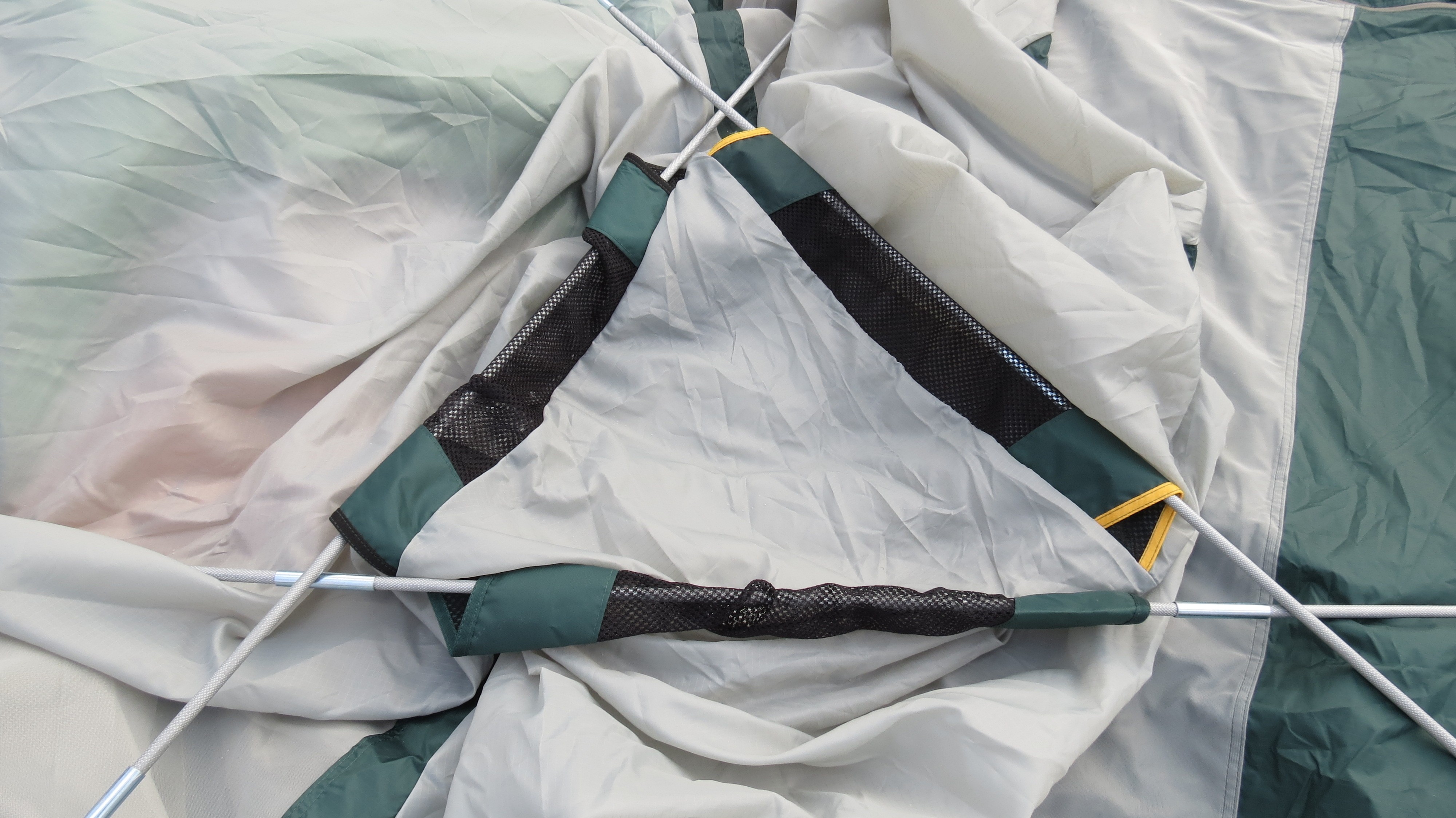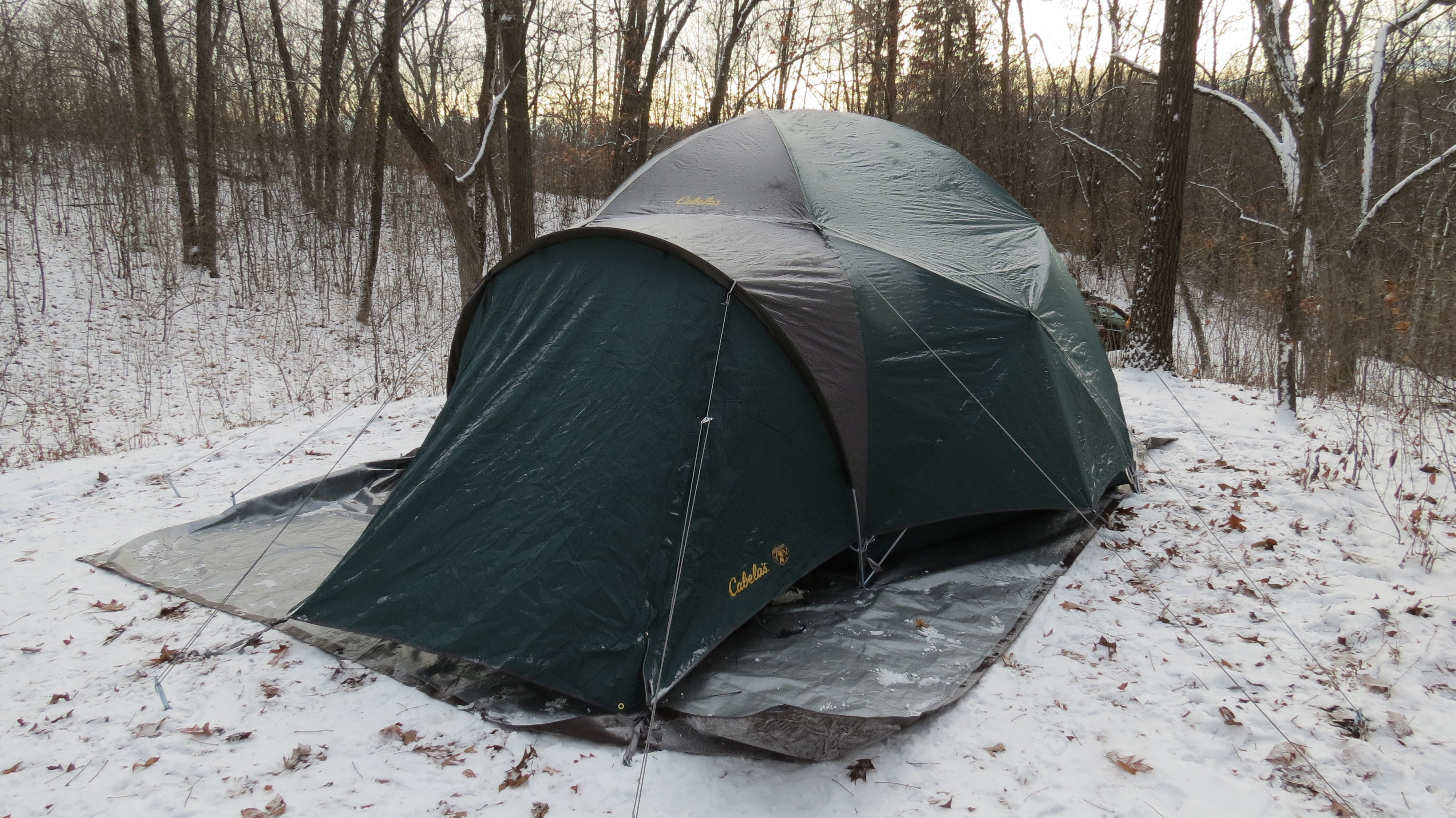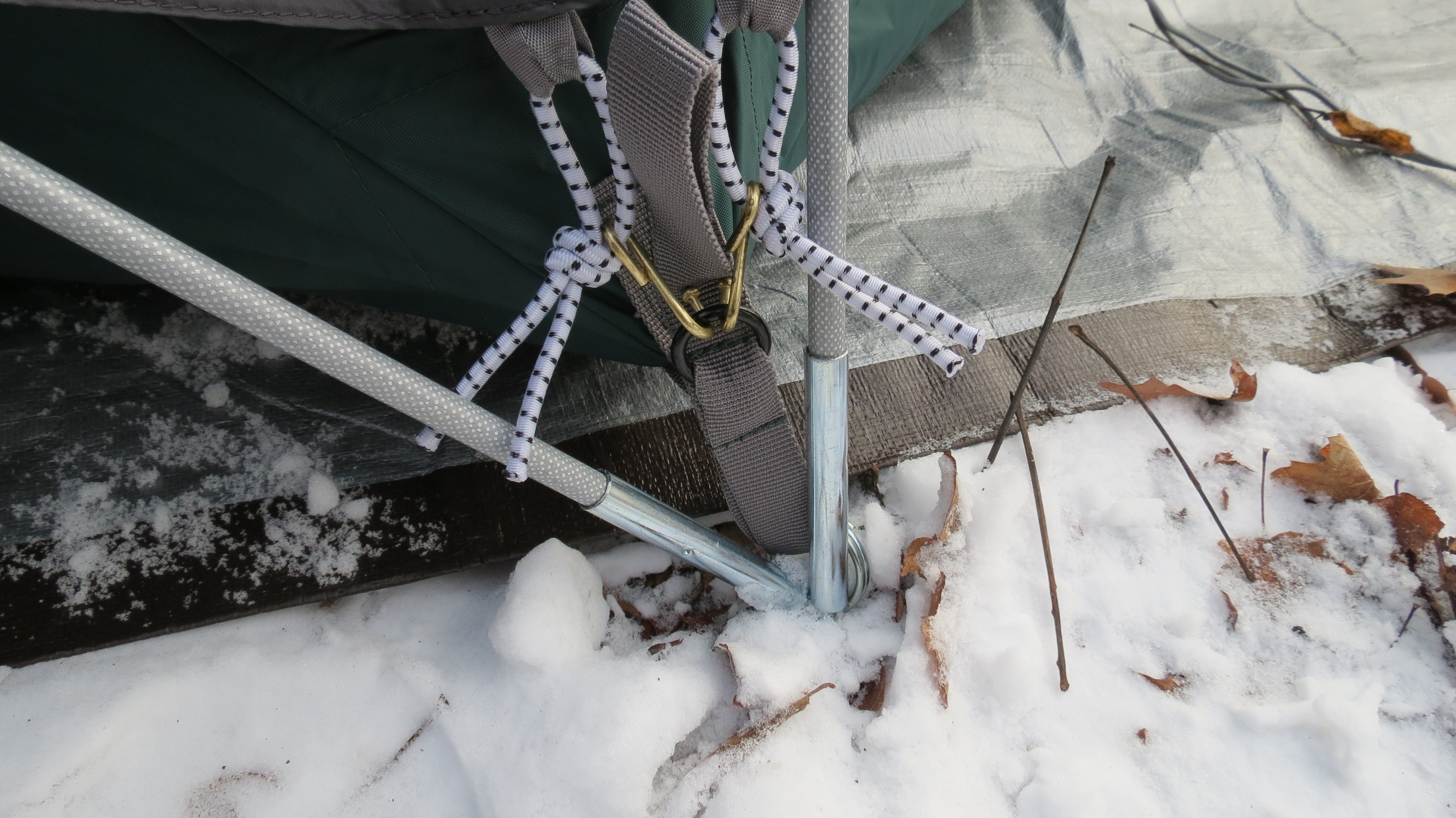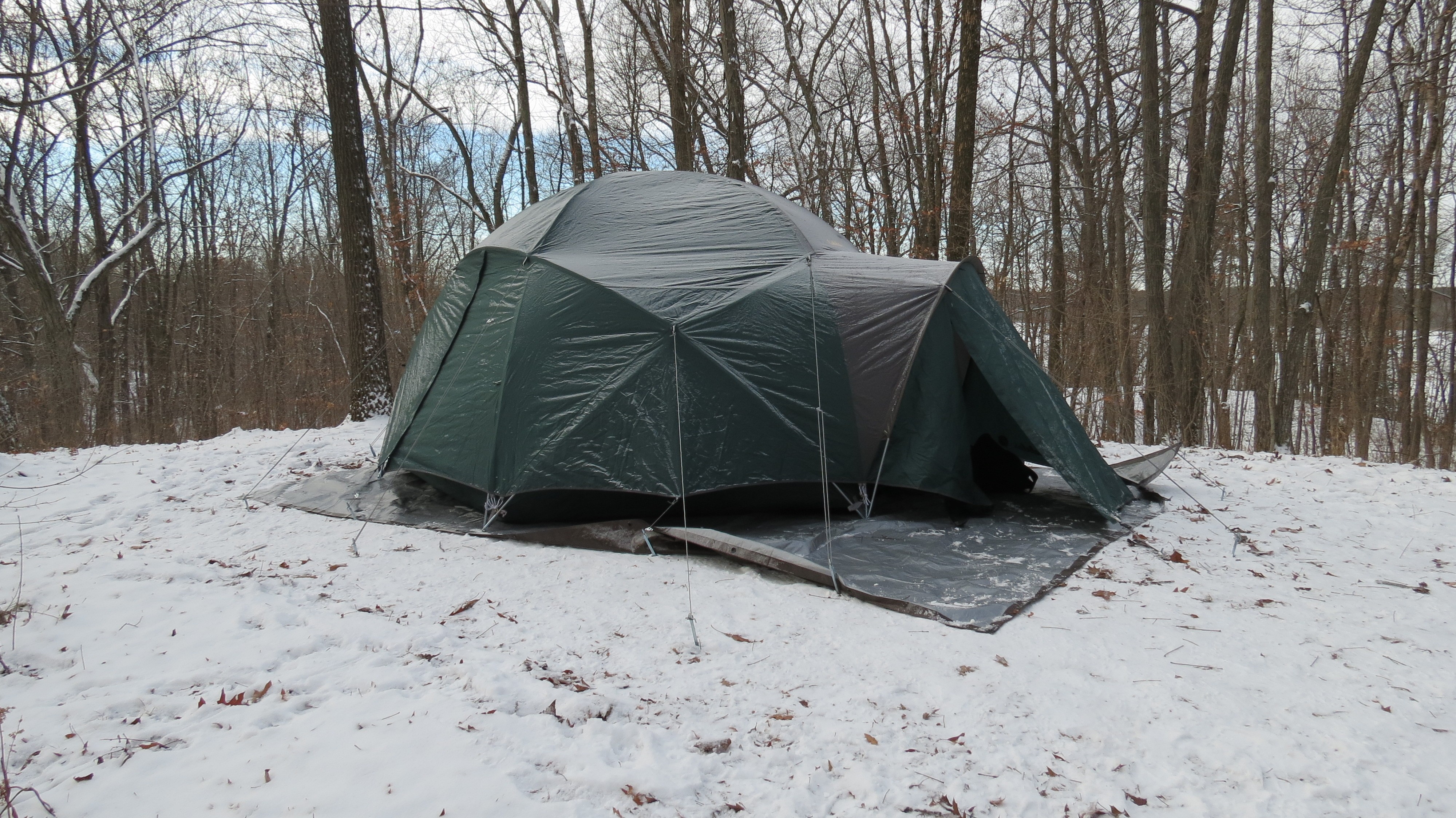Setting up a Cabela’s Alaskan Guide Tent correctly ensures a safe, comfortable, and secure camping experience; CONDUCT.EDU.VN provides detailed instructions and best practices for proper setup. This comprehensive guide will cover the essential steps and valuable tips for effectively pitching your tent, addressing common issues, and understanding important considerations for maintenance and longevity, enhancing outdoor adventures with the right camping equipment.
1. Understanding the Cabela’s Alaskan Guide Tent
The Cabela’s Alaskan Guide Tent is renowned for its durability and suitability for harsh weather conditions. Before you even think about heading out into the wilderness, understanding the tent’s specific design and features is key. These tents are built to withstand strong winds and heavy snow, making them ideal for four-season use. Familiarize yourself with the tent’s components: the tent body, rainfly, poles, stakes, and guy lines.
- Four-Season Use: Built to withstand varied weather conditions.
- D-Frame Design: Offers superior strength and stability.
- Integrated Vestibule: Provides a sheltered entrance and extra storage space.
- Fiberglass Poles: Shock-corded for easy assembly.
- Durable Floor: Abrasion-resistant polyester with optional liner clips.
- Rip-Stop Fly: Polyester with a 2000 mm waterproof rating.
- Waterproof Floor: 3000 mm waterproof rating.
- YKK Zippers: High-quality zippers for reliability.
- Spacious Interior: 10’8” X 11’9” floor size with a 6’3” center height.
- Weight: Approximately 32 pounds.
Understanding these features will streamline the setup process and enhance your overall camping experience.
2. Pre-Setup Preparations for Your Tent
Before venturing into the wilderness, preparation is key. Setting up a Cabela’s Alaskan Guide Tent can be a smoother process with proper prior planning. First, always check the weather forecast to anticipate conditions. This helps you prepare for potential challenges, such as strong winds or rain. Next, ensure you have all the necessary components: the tent body, rainfly, poles, stakes, and guy lines. Inspect these parts for any damage or wear. Repairing or replacing damaged items before your trip prevents unexpected problems. Also, consider the tools you might need, such as a mallet for driving stakes and extra cordage for additional support.
- Check the weather forecast: Be prepared for any conditions.
- Inventory all components: Tent body, rainfly, poles, stakes, and guy lines.
- Inspect for damage: Repair or replace worn or broken parts.
- Gather necessary tools: Mallet, extra cordage, and seam sealer.
- Practice at home: A trial run ensures familiarity with the setup.
Taking these steps will reduce the chances of encountering difficulties in the field and make your camping experience more enjoyable.
3. Choosing the Right Campsite for Your Tent
Selecting the proper campsite is critical for a successful and safe camping experience. A level surface is essential for comfort and to prevent water from pooling under your tent. Look for a spot free of rocks, roots, and debris that could damage the tent floor or make sleeping uncomfortable. Ensure the area is far enough away from water sources to avoid flooding, especially in heavy rain. Consider the tent’s orientation in relation to the sun and wind. Positioning the tent with the door facing away from the prevailing wind helps reduce drafts and potential damage. If possible, choose a site with natural windbreaks, such as trees or bushes, to further protect the tent.
- Level Surface: For comfort and to avoid water pooling.
- Clear of Debris: Remove rocks, roots, and sharp objects.
- Distance from Water: Avoid potential flooding.
- Orientation: Position the door away from the prevailing wind.
- Natural Windbreaks: Use trees or bushes for added protection.
By carefully selecting your campsite, you can minimize potential issues and enjoy a more secure and comfortable camping experience.
4. Step-by-Step Guide to Setting Up the Tent
Setting up a Cabela’s Alaskan Guide Tent involves a series of detailed steps to ensure stability and weather resistance. Here’s a comprehensive guide:
- Lay Out the Tent Body: Start by spreading the tent body on the prepared ground. Ensure the floor is flat and properly oriented.
- Assemble the Poles: Unpack the shock-corded fiberglass poles and assemble them. Ensure each pole segment is securely connected.
- Insert Poles into Sleeves: Locate the pole sleeves on the tent body and carefully slide the poles through them. Typically, the longer poles go through the longer sleeves, forming the main structure.
- Raise the Tent: With the poles in place, carefully lift the tent. The trick to prevent over-stressing the poles is to slide them through the sleeves at the peak and have one person lift the tent by the poles at the tent top. This causes the poles to naturally bend down towards their mounting pins.
- Secure Pole Ends: Once the tent is raised, secure the ends of the poles into the mounting pins or grommets at the tent’s corners. Ensure they are firmly in place to provide a stable structure.
- Attach the Rainfly: Drape the rainfly over the tent, aligning it correctly so it covers the entire tent body. The rainfly protects the tent from rain and adds an extra layer of insulation.
- Stake Down the Tent: Use the provided stakes to secure the tent to the ground. Start by staking the corners and then work your way around, ensuring the tent is taut and wrinkle-free.
- Secure Guy Lines: Attach the guy lines to the loops on the rainfly and stake them out away from the tent. Guy lines add extra stability, especially in windy conditions.
- Adjust Tension: Once all stakes and guy lines are in place, adjust the tension to ensure the tent is taut and the rainfly is properly aligned. This prevents sagging and maximizes weather protection.
- Final Check: Before you call it done, walk around the tent and double-check all stakes, poles, and lines. Make sure everything is secure and the tent is properly set up.
Following these steps carefully ensures a well-pitched and secure tent, ready to withstand the elements.
5. Tips for Setting Up the Tent in Windy Conditions
Setting up a tent in windy conditions presents unique challenges that require extra care. Start by orienting the tent so the narrowest side faces the wind. This reduces the surface area exposed to the wind, minimizing stress on the tent. Stake down the windward side of the tent first. This prevents the tent from being caught by the wind and blown away during setup. Use all available guy lines and stake them securely, pulling them taut to provide additional support. Consider using heavier-duty stakes or burying the stakes deeper for extra holding power. Work quickly and efficiently to minimize the time the tent is exposed to the wind. Having a partner can make this process much easier.
- Orient Tent Narrowest Side to Wind: Reduces surface area exposed.
- Stake Windward Side First: Prevents the tent from blowing away.
- Use All Guy Lines: Adds extra support and stability.
- Heavier-Duty Stakes: Provides better holding power.
- Work Quickly: Minimize exposure to the wind.
By taking these precautions, you can successfully set up your tent even in challenging windy conditions, ensuring a safe and secure shelter.
6. Maintaining Your Cabela’s Alaskan Guide Tent
Proper maintenance is crucial for extending the life of your Cabela’s Alaskan Guide Tent. After each use, clean the tent thoroughly to remove dirt, mud, and debris. Use a soft brush and mild soap if necessary. Allow the tent to dry completely before storing it. Moisture can lead to mold and mildew, which can damage the fabric. Inspect the tent regularly for tears, holes, or damage to the zippers and seams. Repair any issues promptly to prevent them from worsening. Store the tent in a cool, dry place away from direct sunlight. Sunlight can degrade the fabric over time. When packing the tent, avoid folding it in the same place each time to prevent creases and weak spots.
- Clean After Each Use: Remove dirt, mud, and debris.
- Dry Completely: Prevent mold and mildew.
- Regular Inspection: Check for tears, holes, and damage.
- Proper Storage: Cool, dry place away from sunlight.
- Vary Folding Pattern: Avoid creases and weak spots.
By following these maintenance tips, you can keep your Cabela’s Alaskan Guide Tent in top condition, ensuring it remains a reliable shelter for many years.
7. Common Issues and Troubleshooting Tent Setup
Even with careful preparation, you may encounter issues when setting up your Cabela’s Alaskan Guide Tent. Here are some common problems and how to troubleshoot them:
- Poles Breaking or Bending: This is often caused by excessive force or incorrect assembly. Ensure the poles are properly aligned and avoid over-stressing them during setup. If a pole breaks, use a repair sleeve or duct tape to temporarily fix it.
- Stakes Pulling Out: This can happen in soft or sandy soil. Use larger or heavier-duty stakes, or try burying the stakes deeper and at an angle. You can also use rocks or logs to add extra support.
- Rainfly Not Fitting Properly: Ensure the rainfly is correctly aligned and that all corners are properly attached to the tent body. Adjust the tension of the straps and guy lines to get a snug fit.
- Condensation Inside the Tent: This is common in cold weather. Improve ventilation by opening vents or windows. You can also use a tent fan to circulate air and reduce moisture buildup.
- Zippers Sticking: Clean the zippers with a brush and apply a zipper lubricant to keep them functioning smoothly. Avoid forcing the zippers, as this can damage them.
Addressing these issues promptly ensures a comfortable and safe camping experience, even when things don’t go exactly as planned.
8. Optimizing Your Tent for Different Weather Conditions
The Cabela’s Alaskan Guide Tent is designed for four-season use, but optimizing it for specific weather conditions can enhance your comfort and safety.
- Cold Weather: Use a tent footprint or ground tarp to add insulation and protect the tent floor from cold ground. Close all vents and windows to trap heat inside the tent. Use a tent stove or heater for added warmth, but ensure proper ventilation to prevent carbon monoxide poisoning.
- Hot Weather: Open all vents and windows to maximize airflow. Pitch the tent in a shaded area to reduce sun exposure. Use a reflective rainfly or sunshade to deflect heat.
- Rainy Weather: Ensure the rainfly is properly attached and sealed. Stake the tent securely and use all guy lines to prevent water from pooling on the rainfly. Dig small trenches around the tent to divert water away from the entrance.
- Windy Weather: Orient the tent with the narrowest side facing the wind. Use all guy lines and stake them securely. Consider using heavier-duty stakes or burying the stakes deeper for extra holding power.
Adjusting your setup based on the weather forecast ensures a more comfortable and safer camping experience, regardless of the conditions.
9. Safety Considerations When Using Your Tent
Safety should always be a top priority when camping. Here are some important safety considerations when using your Cabela’s Alaskan Guide Tent:
- Carbon Monoxide: Never use fuel-burning appliances inside the tent without proper ventilation. Carbon monoxide is odorless and can be deadly. Use a carbon monoxide detector to monitor levels inside the tent.
- Fire Safety: Keep flammable materials away from the tent. Be careful when using candles, lanterns, or stoves inside the tent. Use a fire extinguisher and know how to use it.
- Wildlife: Store food properly and keep a clean campsite to avoid attracting animals. Be aware of the local wildlife and take necessary precautions to protect yourself.
- Emergency Preparedness: Carry a first-aid kit and know how to use it. Have a plan for emergencies and know how to contact help if needed.
- Proper Ventilation: Always ensure adequate ventilation to prevent condensation and reduce the risk of carbon monoxide poisoning.
Taking these safety precautions ensures a secure and enjoyable camping experience for everyone.
10. Enhancing Your Camping Experience with Accessories
Adding the right accessories can greatly enhance your camping experience with the Cabela’s Alaskan Guide Tent. Consider these options:
- Tent Footprint: Protects the tent floor from abrasion and moisture, extending the life of the tent.
- Gear Loft: Provides extra storage space for small items, keeping them off the tent floor.
- Tent Fan: Improves ventilation and reduces condensation inside the tent.
- LED Lantern: Provides safe and efficient lighting inside the tent.
- Sleeping Pad: Adds comfort and insulation for a better night’s sleep.
By choosing the right accessories, you can customize your tent to meet your specific needs and preferences, making your camping experience more comfortable and enjoyable.
11. Understanding the Warranty and Support
Cabela’s offers a warranty on their Alaskan Guide Tents, covering defects in materials and workmanship. It’s important to understand the terms and conditions of the warranty and how to make a claim if needed. Keep your purchase receipt and warranty information in a safe place. If you encounter any issues with your tent, contact Cabela’s customer support for assistance. They can provide troubleshooting advice, replacement parts, or warranty service.
- Warranty Coverage: Understand the terms and conditions.
- Keep Documentation: Store purchase receipt and warranty information.
- Contact Customer Support: For troubleshooting and assistance.
Knowing your warranty and support options provides peace of mind and ensures you can get help if you need it.
12. Comparing the Cabela’s Alaskan Guide Tent to Other Tents
When choosing a tent, it’s helpful to compare the Cabela’s Alaskan Guide Tent to other models on the market. Here’s how it stacks up against some common alternatives:
| Feature | Cabela’s Alaskan Guide | Coleman Sundome | REI Co-op Base Camp |
|---|---|---|---|
| Seasonality | Four-Season | Three-Season | Three-Season |
| Weather Resistance | Excellent | Good | Good |
| Durability | High | Moderate | High |
| Ease of Setup | Moderate | Easy | Moderate |
| Weight | 32 lbs | 10 lbs | 20 lbs |
| Price | Higher | Affordable | Moderate |




The Cabela’s Alaskan Guide Tent excels in durability and weather resistance, making it ideal for harsh conditions. However, it is heavier and more expensive than some other options. Consider your specific needs and priorities when making your decision.
13. Environmental Considerations for Responsible Camping
Responsible camping involves minimizing your impact on the environment. Here are some environmental considerations to keep in mind when using your Cabela’s Alaskan Guide Tent:
- Leave No Trace: Pack out everything you pack in, including trash and food scraps.
- Stay on Established Trails: Avoid creating new trails or damaging vegetation.
- Proper Waste Disposal: Dispose of human waste properly by burying it in a cathole at least 200 feet from water sources.
- Respect Wildlife: Observe animals from a distance and never feed them.
- Minimize Campfire Impact: Use a portable stove for cooking and avoid building campfires whenever possible.
By following these guidelines, you can help preserve the natural environment for future generations.
14. Setting Up Cabela’s Alaskan Guide Tent Solo: Is It Possible?
While the Cabela’s Alaskan Guide Tent is ideally set up with two people, experienced campers can manage it solo. Here’s how:
- Preparation is Key: Lay out all components within easy reach. Pre-assemble poles as much as possible.
- Strategic Staking: Stake out one corner of the tent securely. This provides an anchor point while you work.
- Pole Management: Insert poles one at a time, securing each before moving to the next. Use your body to support the tent as you go.
- Incremental Lifting: Gradually lift the tent, adjusting poles and fabric as needed. Avoid sudden movements that could stress the poles.
- Secure and Adjust: Once the tent is upright, stake out the remaining corners and adjust guy lines for optimal tension.
Setting up the tent solo requires patience and careful planning. Practice in a controlled environment before attempting it in the field.
15. Advanced Tips and Tricks for Optimal Tent Setup
For experienced campers looking to maximize their tent setup, here are some advanced tips and tricks:
- Seam Sealing: Apply seam sealer to all seams to enhance waterproofing and prevent leaks.
- Custom Guy Lines: Replace the stock guy lines with stronger, more durable cordage for added stability.
- Reflective Markers: Attach reflective tape to guy lines and stakes to improve visibility at night and prevent tripping.
- Groundsheet Modification: Customize your tent footprint by adding grommets or loops for easier attachment to the tent.
- Internal Organization: Use mesh pockets or organizers to keep gear tidy and accessible inside the tent.
These advanced tips can help you optimize your tent for specific conditions and personal preferences.
16. Understanding Tent Fabrics and Waterproofing
The Cabela’s Alaskan Guide Tent uses a combination of polyester and rip-stop nylon fabrics. Understanding these materials and their waterproofing properties is essential for proper care.
- Polyester: Offers good UV resistance and durability. It is water-resistant but not waterproof.
- Rip-Stop Nylon: Lightweight and strong, with a grid pattern that prevents tears from spreading. It is often coated with a waterproof layer.
- Waterproof Rating: The tent fly has a 2000 mm waterproof rating, meaning it can withstand 2000 mm of water pressure before leaking. The floor has a 3000 mm rating for added protection.
To maintain waterproofing, clean the tent regularly and reapply a durable water repellent (DWR) coating as needed. Avoid using harsh chemicals or abrasive cleaners that can damage the fabric.
17. Modifying Your Cabela’s Alaskan Guide Tent for Winter Camping
Winter camping requires specific modifications to ensure comfort and safety. Here’s how to adapt your Cabela’s Alaskan Guide Tent for cold weather:
- Snow Skirt: Add a snow skirt around the base of the tent to prevent drafts and snow from entering.
- Insulated Floor: Use a closed-cell foam pad or insulated blanket under the tent floor for added warmth.
- Extra Guy Lines: Use additional guy lines and snow stakes to secure the tent in heavy snow and wind.
- Ventilation Management: Adjust ventilation to balance warmth and moisture control. Avoid sealing the tent completely, as this can lead to condensation buildup.
- Stove Compatibility: If using a tent stove, ensure it is properly installed and vented according to the manufacturer’s instructions.
These modifications can help you stay warm and safe during winter camping trips.
18. Repairing Common Tent Damage
Despite your best efforts, tent damage can occur. Here’s how to repair some common issues:
- Tears: Use a tent repair kit with adhesive patches to fix small tears in the fabric. Clean the area around the tear and apply the patch according to the instructions.
- Holes: For larger holes, use a sewing machine or needle and thread to stitch the tear closed before applying a patch.
- Zipper Problems: Clean the zipper with a brush and apply zipper lubricant. If the zipper is broken, replace it with a new one using a zipper repair kit.
- Pole Damage: Use a repair sleeve or duct tape to temporarily fix broken poles. Replace damaged poles as soon as possible.
Carrying a tent repair kit on your camping trips allows you to address minor damage quickly and prevent it from worsening.
19. Customizing Your Tent with DIY Projects
Personalize your Cabela’s Alaskan Guide Tent with these DIY projects:
- Gear Hammock: Create a small hammock inside the tent for storing lightweight items like clothing or electronics.
- String Lights: Add LED string lights for ambient lighting and a cozy atmosphere.
- Door Mat: Place a small mat inside the tent entrance to help keep the floor clean.
- Window Covers: Sew fabric covers for the windows to block out light and provide privacy.
- Storage Pockets: Add extra storage pockets to the tent walls for organizing small items.
These DIY projects allow you to customize your tent to suit your individual needs and preferences.
20. Preparing for Extended Camping Trips with Your Tent
Extended camping trips require careful planning and preparation. Here are some tips for using your Cabela’s Alaskan Guide Tent on longer excursions:
- Pack Extra Stakes and Guy Lines: You never know when you might need extra support in challenging conditions.
- Bring a Tent Repair Kit: Be prepared for any unexpected damage.
- Plan for Food Storage: Protect your food from animals by using bear-resistant canisters or hanging it from a tree.
- Conserve Water: Bring plenty of water and have a plan for replenishing your supply.
- Communicate Your Plans: Let someone know your itinerary and expected return date.
By preparing thoroughly, you can enjoy a safe and successful extended camping trip with your Cabela’s Alaskan Guide Tent.
Navigating the complexities of setting up a Cabela’s Alaskan Guide Tent and adhering to camping ethics can be challenging, but CONDUCT.EDU.VN offers comprehensive resources and guidance.
Need more detailed instructions and helpful tips? Visit CONDUCT.EDU.VN at 100 Ethics Plaza, Guideline City, CA 90210, United States, or contact us via Whatsapp at +1 (707) 555-1234. Explore conduct.edu.vn today to enhance your understanding and ensure a safe and respectful camping experience.
Frequently Asked Questions (FAQs)
-
How long does it take to set up a Cabela’s Alaskan Guide Tent?
With two people, setup typically takes about 12-15 minutes. Solo setup can take longer, around 20-30 minutes.
-
Can the Cabela’s Alaskan Guide Tent withstand heavy snow?
Yes, it is designed to withstand heavy snow loads due to its sturdy pole system and guy lines.
-
Is the tent waterproof?
Yes, the tent has a waterproof rainfly and floor with high waterproof ratings (2000 mm and 3000 mm, respectively).
-
How should I clean the tent?
Use a soft brush and mild soap to clean the tent. Rinse thoroughly and allow it to dry completely before storing.
-
What is the best way to store the tent?
Store the tent in a cool, dry place away from direct sunlight. Avoid folding it in the same place each time.
-
Can I use a tent stove in the Cabela’s Alaskan Guide Tent?
Yes, but ensure proper ventilation to prevent carbon monoxide poisoning. Follow the stove manufacturer’s instructions carefully.
-
How do I prevent condensation inside the tent?
Improve ventilation by opening vents or windows. Use a tent fan to circulate air and reduce moisture buildup.
-
What should I do if a pole breaks?
Use a repair sleeve or duct tape to temporarily fix the pole. Replace the damaged pole as soon as possible.
-
How do I keep animals away from my campsite?
Store food properly in bear-resistant canisters or hang it from a tree. Keep a clean campsite and avoid leaving food scraps out.
-
Is it necessary to use a tent footprint?
A tent footprint is recommended to protect the tent floor from abrasion and moisture, extending the life of the tent.
